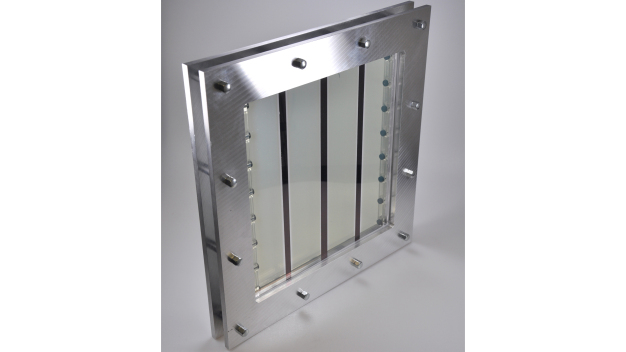- Science
Compact power plants for green hydrogen
Hydrogen generated with the power of the sun could largely replace fossil fuels in the future, helping to lower carbon emissions. In the Neo-PEC joint research project, Fraunhofer specialists have developed a tandem module that is self-sufficient and reliable at producing solar-generated green hydrogen.
Hydrogen is a key starting point in transforming industrial processes for lower climate impact. However, a fuel that combusts without releasing CO2 should also be produced without any carbon footprint if at all possible. One classic process for this is electrolysis, in which electricity is used to break water down into hydrogen and oxygen. If the electricity needed for electrolysis comes from renewable sources like solar panels, the result is green hydrogen. The disadvantage is that the electrolyzers needed for this process are typically large, highly complex systems. This costly and high-maintenance equipment is also in increasingly short supply right now, especially amid current developments in global climate policies.
Solar hydrogen generation
Direct use of solar energy to split water using what is called a photoelectrochemical cell (PEC) offers an exciting alternative. In the Neo-PEC joint research project, researchers from three Fraunhofer institutes have come together to develop a modular solution that enables highly flexible hydrogen generation and supply with solar energy.
The centerpiece of this Fraunhofer development is a tandem PEC module. It is similar to its traditional photovoltaic counterpart, but with one crucial difference: The electricity is not generated for purposes of later electrolysis elsewhere. The entire process takes place in one and the same unit. Caution is needed throughout: Since the process results in hydrogen and oxygen, the structure must be designed to maintain a strict separation between the two elements during generation and beyond.
To produce the tandem cell, the experts coat standard commercially available float or plate glass with semiconducting materials on both sides. When the sunlight hits the glass, one side of the module absorbs the short-wavelength light. At the same time, the long-wavelength light passes through the upper layer of glass and is absorbed on the reverse side. The module releases hydrogen on the reverse or cathode side and oxygen on the upper side, which is the anode side.
Over the project’s three-year term, the Fraunhofer scientists researched and developed high-purity semiconductor materials, which they apply using ultra-gentle coating methods. This allows them to increase the method’s hydrogen yield.
“We use the vapor phase to form layers just a few nanometers thick on the glass. The structures created in the process have a huge impact on reactor activity, in addition to the actual material properties, which we have also optimized,” explains Dr. Arno Görne, group manager of Functional Materials for Hybrid Microsystems at the Fraunhofer Institute for Ceramic Technologies and Systems IKTS. The photovoltaic elements linked in the module supply the system with additional voltage – a turbo that accelerates activity while additionally boosting efficiency.
Safety and practicality, squared
The result is a reactor with an active surface area of half a square meter. Separated from the oxygen, it generates the hydrogen, which can be captured and quantified directly. Right now, a single module exposed to sunlight under European conditions can generate over 30 kilograms of hydrogen per year over 100 square meters. With this yield, a hydrogen car could travel 15,000 to 20,000 kilometers, for example.
“In terms of the dimensions of the tandem cell, we are limited by the fact that our module splits the water directly, but it is also necessary for electricity to get from one side to the other to achieve this. As the module area increases, the rising resistance has an unfavorable effect on the system. As things currently stand, the existing format has proven to be optimum. It is stable, robust, and significantly larger than any comparable solution,” Görne notes. The compact elements can be connected as needed without any negative side effects, from a single module to large areas – a significant advantage for the Fraunhofer solution.
Linking expertise
The project, now concluded, is also a successful example of cross-institution collaboration and combination of complementary Fraunhofer expertise. Fraunhofer IKTS researched materials and processing for the photoactive layer. The colleagues at the Fraunhofer Institute for Surface Engineering and Thin Films IST contributed their experience in using physical vapor deposition to coat large areas. The reactor design, low-cost and reliable production, and subsequent evaluation of the modules was in the hands of the experts at the Fraunhofer Center for Silicon Photovoltaics CSP.
The project partners have already conducted numerous field tests demonstrating stable and smooth operation of both the module and the interconnections. But that is not the end for the Fraunhofer teams, who first unveiled their reactor at the Achema 2024 trade show in Frankfurt in June, as they started planning their next steps long ago. First, they are planning to continue their successful cross-institute collaboration in a follow-up project, and second, they intend to further develop their solution in various directions in collaboration with the private sector – for direct, safe, and efficient decentralized generation and supply of hydrogen.
Fraunhofer-Institut für Keramische Technologien und Systeme IKTS
01277 Dresden
Germany









